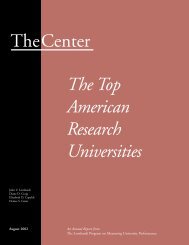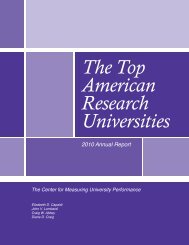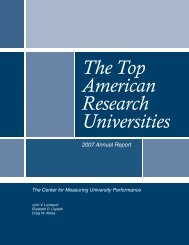The Top American Research Universities - The Center for ...
The Top American Research Universities - The Center for ...
The Top American Research Universities - The Center for ...
You also want an ePaper? Increase the reach of your titles
YUMPU automatically turns print PDFs into web optimized ePapers that Google loves.
216<br />
discipline are coded as “all.” We identify institutions with 75-94%<br />
in one area as “heavy” and label those with 50-74% of their<br />
expenditures concentrated as “strong.” Other universities with<br />
25-49% in one or more disciplines we describe as “moderate.”<br />
A few institutions (but none in the more than $20 million group)<br />
have expenditures distributed fairly evenly across the disciplines;<br />
those we code as “mixed.”<br />
In some cases, where an institution reports as a multi-campus<br />
entity, we made adjustments to break out the discipline-level<br />
expenditure data by single campus. Typically, this involved moving<br />
all or a portion of the life sciences expenditures to the health<br />
or medical center campus. IPEDS fall enrollment and graduate<br />
degrees by discipline data also were used to help in this ef<strong>for</strong>t.<br />
While these data offer some insight as to the research structure<br />
of a university, their usefulness is limited. For example, we<br />
may be tempted to use the life sciences as a surrogate <strong>for</strong> medical<br />
research, but we must remember that they also include agricultural<br />
and biological sciences. Further, the growing trend toward<br />
multidisciplinary and interdisciplinary projects may make it more<br />
difficult <strong>for</strong> universities to accurately reflect expenditures by<br />
discipline or sub-discipline. <strong>The</strong> <strong>Center</strong> chooses not to break out<br />
these sub-disciplines because the data are increasingly prone to<br />
error as further adjustments are made.<br />
Student Characteristics<br />
Fall Enrollment<br />
Source: NCES IPEDS Fall Enrollment Survey, 2006.<br />
Each November, institutions report their current fall headcount<br />
enrollment to the IPEDS Fall Enrollment Survey. Enrollment<br />
figures include both degree seeking and non-degree seeking students.<br />
<strong>The</strong> <strong>Center</strong> provides the headcount enrollment by level as<br />
presented by IPEDS, along with the percentage of those attending<br />
part-time. Graduate students include those seeking specialist<br />
degrees in engineering and education. First professional students<br />
<strong>The</strong> <strong>Center</strong> <strong>for</strong> Measuring University Per<strong>for</strong>mance<br />
<strong>The</strong> <strong>Top</strong> <strong>American</strong> <strong>Research</strong> <strong>Universities</strong><br />
include those seeking degrees in medical fields, such as Chiropractic,<br />
Dentistry, Medicine, Optometry, Osteopathic Medicine,<br />
Pharmacy, Podiatry, and Veterinary Medicine, as well as those<br />
seeking degrees in Law and <strong>The</strong>ology.<br />
Each campus in our study submits enrollment data by campus,<br />
except <strong>for</strong> the few institutions identified in our Data Notes<br />
section. Because this is an in<strong>for</strong>mational item and not one of<br />
<strong>The</strong> <strong>Center</strong>’s nine quality measures, we did not attempt to adjust<br />
these figures.<br />
AAMC Federal <strong>Research</strong><br />
Source: Association of <strong>American</strong> Medical Colleges<br />
<strong>The</strong> Association of <strong>American</strong> Medical Colleges data on federally<br />
sponsored research at medical colleges through the Liaison<br />
Committee on Medical Education (LCME) Part I-A, Annual Financial<br />
Questionnaire. We calculate each medical school’s federal<br />
R&D by summing the recorded dollars and a portion of the relative<br />
administrative costs. We exclude the not-recorded dollars.<br />
1 Academic R&D Expenditures, FY 2000: Technical Notes<br />
(On-line: http://www.nsf.gov/sbe/srs/nsf02308/secta.htm)<br />
2 National Patterns of R&D Resources, 1998: Technical Notes<br />
(On-line: http://www.nsf.gov/sbe/srs/nsf99335/appa.htm<br />
3 College and University Higher Education Price Index, 2005<br />
Update, <strong>Research</strong> Associates of Washington, Washington, DC.<br />
4 National Patterns of R&D Resources, 1998: Technical Notes<br />
(On-line: http://www.nsf.gov/sbe/srs/nsf99335/appa.htm)<br />
5 Survey Methodology: Survey of Graduate Students<br />
and Postdoctorates in Science and Engineering (On-line:<br />
http://www.nsf.gov/statistics/srvygradpostdoc/)








